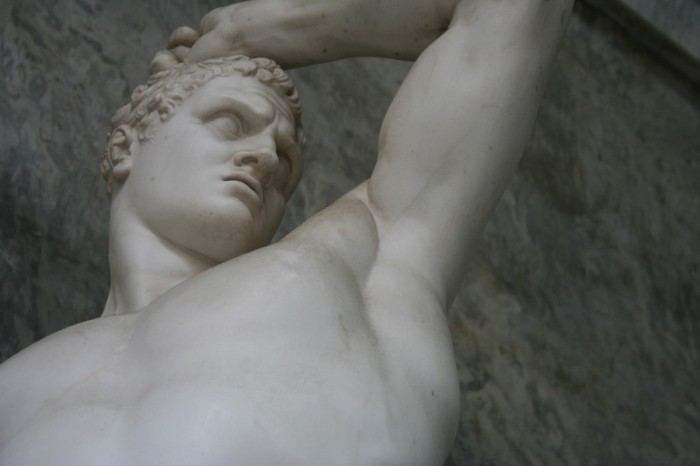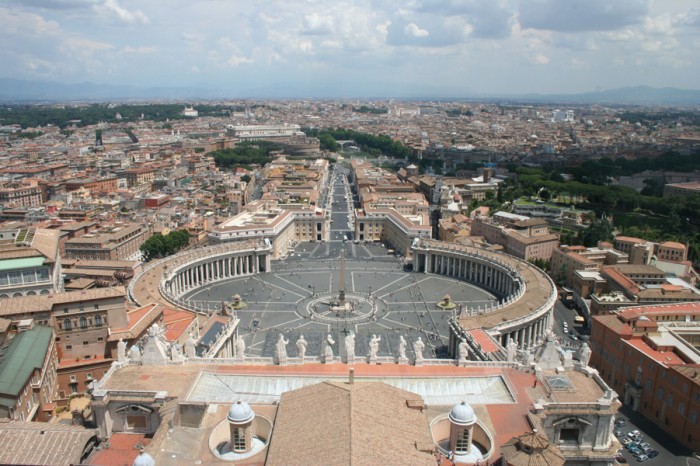June 8th, 2007 by Rachel | Country: Italy | No Comments »
I am standing in a large well-known room and looking at the ceiling with an expected astonishment. My eyes gaze at the familiar images that I have seen in art history textbooks throughout my life. Two nude guys touching each other’s finger, a famous image called “The Creation of Adam,” and more and more and more beautiful images – “Adam and Eve,” “The Last Judgment,” and the “Syphilis.” These paintings were beautifully drawn and painted with chiaroscuro. I could see the muscles of the people – the puffiness in the chest and the arms. The folds of the fabric of people’s clothes were realistically rendered in three-dimensional. This man who did this massive project was an outrageously gifted artist. I was looking at Michelangelo’s well-known painting at the Sistine Chapel.

I went to the Musei Vaticani and the St. Peter’s Church today where I saw Michelango’s magnificent fresco painting. As I was walking through the halls of the museum, my eyes stared at the ceilings nearly during my entire passage. These ceilings are filled with fresco paintings like Michelangelo’s fresco painting in the Sistine Chapel. They are filled with details of images from the Bible. Even though I am not religious, I can still appreciate these images because of the amazing techniques that the artists used. The use of coloring, the composition, and chiaroscuro are phenomenal. It’s unfortunate that fresco paintings don’t exist often today since they are beautiful. However, during that time, the Renaissance period and even during the Medieval too, extensive amount of art in church was important because the churches were trying to attract people to come to the services and practice their religion. In other words, the extensive decoration in the churches was propaganda. However, during the Reformation period, a period that took place during 16th century, after Renaissance period, changed the idea of overly done decorations in churches slightly. In several countries, in particular in the northern Europe, many group of people became against the Catholic concept and lead to a new set of Christian movement called the Protestant. The Protestant argued for simple church designs, use only existed bible characters in the designs whereas the Catholics were constantly creating new “make-believe” bible characters. The Protestants became less religious than the Catholics. So, when you travel to Europe and visit some churches, you will understand why some churches are overly elaborated with decorations and why some others are plainly simple.
The Vatican Museum has one of the most famous and magnificent sculpture piece, the Laocoön and His Sons, created by Agesander, Athenodoros, and Polydorus. It depicts great dynamic energy and drama as Laocoon and his sons are fighting to escape from the serpent.
St. Peter’s church is again, OVERLY elaborated with extensive decorations including sculptures such as Michelangelo’s Pieta and fresco paintings. The church is absolutely stunning and looks as if over 100 artists were involved in the church design. I went to the top of the dome, and my goodness, climbing up the steps was just as arduous as climbing up the steps to the second floor of the Eiffel Tower last year or probably worse as the steps were really small, and the halls were very narrow. There is NO way that obese people could pass through this hall of steps. Even though it was a lot of steps to take, once I got up there, it was worth seeing the beautiful view of the city of Rome. I was able to see the beautiful mountains in the backdrop, and the lavishing green countryside.

On the way back to the hotel from the Vatican, I visited the Ara Pacis Museum where I saw a magnificent Roman relief sculpture monument, Ara Pacis Augustae. It’s a large rectangular marble box with relief sculptures on the outside and inside walls. This piece was created to celebrate Augustae’s victory to leading the peace in Gaul and Spain.



























